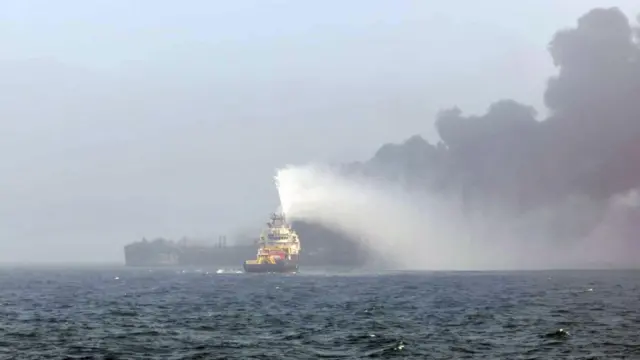Maritime Accident Causes Fire, Leaves Dozens Injured, and Threatens the Environment
On Monday (10), a severe collision between a cargo ship and a tanker chartered by the United States Army triggered a large-scale fire, leaving dozens injured and raising concerns about environmental damage. The accident occurred off the northeast coast of England, about 16 kilometers from the shore, in the North Sea.
According to transport magazine Lloyd’s List and maritime intelligence company VesselFinder, the Portuguese-flagged container ship, identified as Solong, was carrying 15 containers of sodium cyanide, a highly toxic compound, as well as an unspecified amount of alcohol. This chemical is widely used in mining and the chemical industry and can release hydrogen cyanide gas, which is extremely lethal to both humans and marine life.

The collision occurred around 10:00 a.m. local time when the Solong struck the Stena Immaculate tanker, which was anchored in the area. The impact caused a series of explosions and a large fire, hindering rescue operations and heightening fears of toxic substance leaks into the water. The fire was visible from miles away, and rescue ships were quickly sent to contain the situation.
Of the 14 crew members aboard the Solong, 13 were rescued alive and taken to the shore for medical treatment. However, one crew member remained missing for hours, leading to a search and rescue operation by the British Coast Guard. By late Monday night, the search was called off without success.
The Stena Immaculate tanker, operated by the American logistics company Crowley, also sustained severe damage, but all of its crew members were safely evacuated. Thirty-six people were treated by emergency services, as reported by Alastair Smith, Chief of Operations at the East Midlands Ambulance Service NHS Trust. Some victims had severe burns and were taken to specialized hospitals in the area.
The Stena Immaculate was transporting aviation fuel (Jet-A1) and marine diesel destined for Killingholme, England. The vessel was part of a long-term charter with the Defense Logistics Agency (DLA), an agency of the U.S. Department of Defense, and its planned route was to refuel in England before heading to the Mediterranean.
Meanwhile, the Solong had departed from the Scottish port of Grangemouth the night before (9) and was en route to Rotterdam, the Netherlands, carrying highly dangerous goods. Sodium cyanide is extremely hazardous because, when it comes into contact with moisture, it can release toxic vapors that threaten both human life and the marine ecosystem.
It is still unknown whether cyanide has leaked into the water, but environmentalists are warning of significant risks. Greenpeace UK expressed concern, emphasizing that both the fuels and the chemicals being transported could pose a significant threat to marine life.
“We are extremely concerned about the multiple toxic risks these chemicals may pose to the ecosystem. The jet fuel that entered the water near a dolphin breeding site is highly toxic to fish and other marine creatures,” said Dr. Paul Johnston, a scientist at Greenpeace Research Laboratories at the University of Exeter.
Mark Sephton, Professor of Organic Geochemistry at Imperial College London, explained that aviation fuels are biodegradable and tend to evaporate quickly, reducing their environmental impact compared to crude oil. However, sodium cyanide represents a much greater threat, as it can contaminate the water and severely affect marine flora and fauna.
The cause of the collision between the two vessels remains unclear. Martyn Boyers, Director of the Port of Grimsby East, expressed confusion about the incident, stating that modern vessels have sophisticated navigation systems designed to prevent accidents.
“It really seems like a mystery. All vessels today have advanced technology to plot safe routes and avoid collisions. It’s hard to suggest what happened, but something went very wrong,” Boyers said.
The Marine Accident Investigation Branch (MAIB) and the Maritime and Coastguard Agency (MCA) have launched an investigation to determine the causes of the accident. There are suspicions of human error, technical failure, or a possible communication breakdown between the vessels.
“How did that ship continue its route until it collided with an anchored tanker? There must have been warning signs. The collision could have been avoided,” Boyers added.
Crowley reported that the collision caused multiple explosions aboard the Stena Immaculate, including the rupture of a cargo tank containing Jet-A1 fuel. The tanker had departed from the Greek port of Agioi Theodoroi last month and was en route for refueling in England.
Maritime authorities are monitoring the area to assess potential leaks and environmental impacts. In response to the accident, new guidelines may be implemented to strengthen navigation safety in the North Sea region.
The UK government stated that emergency measures are being taken to prevent a large-scale environmental disaster. Maritime safety experts suggest that stricter monitoring and communication protocols between vessels should be adopted to prevent similar incidents in the future.
While the investigation continues, environmentalists, transportation companies, and regulatory agencies will closely monitor the developments of this accident, which is already considered one of the most severe on the British coast in recent years.
The collision between the Solong and the Stena Immaculate exposes vulnerabilities in maritime safety and raises questions about the environmental risks involved in transporting hazardous cargos. With the investigation ongoing, authorities and experts are closely monitoring the situation to prevent a potential environmental disaster of catastrophic proportions.

